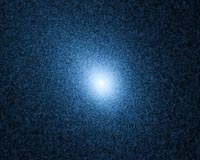 |
Pasadena CA (JPL) Oct 06, 2010 NASA's Wide-field Infrared Survey Explorer, or WISE, caught a glimpse of the comet that the agency's EPOXI mission will visit in November. The WISE observation will help the EPOXI team put together a large-scale picture of the comet, known as Hartley 2. "WISE's infrared vision provides data that complement what EPOXI will see with its visible-light and near-infrared instruments," said James Bauer, of NASA's Jet Propulsion Laboratory, Pasadena, Calif. "It's as if WISE can see an entire country, and EPOXI will visit its capital." WISE's infrared vision will allow the telescope to get a new estimate of the size of the comet's nucleus, or core, as well as a more thorough look at the sizes of dust particles that surround it. This information, when combined with what EPOXI finds as it gets closer to Hartley 2, will reveal how the comet has changed over time. On Nov. 4, the EPOXI mission, which uses the already "in flight" Deep Impact flyby spacecraft, will reach its closet approach to Hartley 2. The spacecraft will examine the dusty, icy body in detail as it flies by, providing the best, extended view of a comet in history. WISE and several other ground- and space-based telescopes are participating in the viewing, working together to tackle mysteries about our solar system's origins that are frozen inside comets. For stargazers, opportunities to view the comet are possible throughout October. On Wednesday, Oct. 20, Hartley 2 will reach its closest approach to Earth since it was discovered in 1986. The comet will be approximately 17.7 million kilometers away (11 million miles) and should be visible with the naked eye near the constellation Perseus if viewed in dark skies. Observers will need binoculars or telescopes from urban areas in the Northern Hemisphere. Southern Hemisphere stargazers will be able to see the comet later in the month. WISE captured its view of the comet during an ongoing scan of the sky in infrared light. The mission has been busy cataloging hundreds of millions of objects, from comets to distant, powerful galaxies. In late September, it used up its frozen cryogen coolant as expected and began a new phase of its survey. Called the NEOWISE Post-Cryogenic Mission, it primarily focuses on finding additional asteroids and comets. To date, the WISE mission has observed more than 150,000 asteroids and 110 comets, including Hartley 2. "Astronomers can reference our catalogue to get detailed infrared data about their favorite asteroid or comet," said Amy Mainzer, the principal investigator of NEOWISE at JPL. "Space missions can also use our observations for more information on their targets, as EPOXI is doing." WISE's view of Hartley 2 was taken on May 10, 2010. It gives astronomers a unique look at the comet, complementing what other telescopes can see. Because WISE scanned the whole sky, it captured the most extensive view of Hartley 2's trail, the dusty path left by the comet on its repeated journey around the sun. Bauer said, "We want to know how the comet behaves as it comes toward the sun and out of deep freeze. The WISE image is one critical puzzle piece of many that will give a comprehensive view of the behavior of the comet through the time of the encounter." The comet started to show signs of activity in the spring, spitting out gas and dust. By July, there were clear jets of gas. "Comparing the dust early on to what we see later with EPOXI helps us understand how the activity started on Hartley 2," said Michael A'Hearn, the principal investigator of EPOXI at the University of Maryland in College Park. The term EPOXI is a combination of the names for the two extended mission components: the Extrasolar Planet Observations and Characterization (EPOCh), and the Hartley 2 flyby, called the Deep Impact eXtended Investigation (DIXI). The name NEOWISE comes from combining WISE and the acronym for near-Earth object, NEO.
Share This Article With Planet Earth
Related Links EPOXI at NASA WISE at NASA WISE at UCLA Asteroid and Comet Mission News, Science and Technology
 Hubble Probes Comet 103P Hartley 2 In Preparation For DIXI flyby
Hubble Probes Comet 103P Hartley 2 In Preparation For DIXI flybyBaltimore MD (SPX) Oct 06, 2010 Hubble Space Telescope observations of comet 103P/Hartley 2, taken on September 25, are helping in the planning for a November 4 flyby of the comet by NASA's Deep Impact eXtended Investigation (DIXI) spacecraft. Analysis of the new Hubble data shows that the nucleus has a diameter of approximately 0.93 miles (1.5 km), which is consistent with previous estimates. The comet is in a hig ... read more |
|
| The content herein, unless otherwise known to be public domain, are Copyright 1995-2010 - SpaceDaily. AFP and UPI Wire Stories are copyright Agence France-Presse and United Press International. ESA Portal Reports are copyright European Space Agency. All NASA sourced material is public domain. Additional copyrights may apply in whole or part to other bona fide parties. Advertising does not imply endorsement,agreement or approval of any opinions, statements or information provided by SpaceDaily on any Web page published or hosted by SpaceDaily. Privacy Statement |